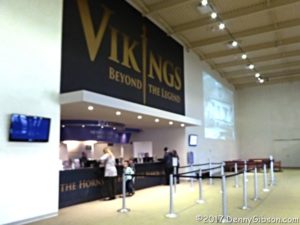 After a couple of aborted attempts, I finally made it to the Vikings: Beyond the Legend exhibit at the Cincinnati Museum Center. A multi-year rehabilitation of Union Terminal, the Museum Center’s home, has begun and has closed all museum areas except for the Children’s Museum, the space used for traveling exhibits such as this, and the ticket and information counter seen at right. The counter is actually the front part of the large ticket and information facility in the center of the terminal’s large rotunda. A portion of the rotunda has been enclosed to provide the pictured entrance area. That impressive rotunda with its huge murals is just on the other side of those walls. The Children’s Museum and the traveling exhibit space are both on the lower level which is what allows them to remain open. A window has been installed along the path to the lower level which allows visitors to peek into some of the emptied and stripped museum space awaiting attention.
After a couple of aborted attempts, I finally made it to the Vikings: Beyond the Legend exhibit at the Cincinnati Museum Center. A multi-year rehabilitation of Union Terminal, the Museum Center’s home, has begun and has closed all museum areas except for the Children’s Museum, the space used for traveling exhibits such as this, and the ticket and information counter seen at right. The counter is actually the front part of the large ticket and information facility in the center of the terminal’s large rotunda. A portion of the rotunda has been enclosed to provide the pictured entrance area. That impressive rotunda with its huge murals is just on the other side of those walls. The Children’s Museum and the traveling exhibit space are both on the lower level which is what allows them to remain open. A window has been installed along the path to the lower level which allows visitors to peek into some of the emptied and stripped museum space awaiting attention.
 The exhibit of more than 500 artifacts opened in November and will remain through April. It is the largest collection of Viking artifacts to ever visit North America and Cincinnati is its first stop. It also has the distinction of being the largest exhibit, in terms of physical size, to appear at the Cincinnati Museum Center. For most, the word Viking conjures up an image of a large rough looking fellow with a huge ax or sword who is constantly pillaging and burning with a little time off to guzzle mead. As the subtitle “Beyond the Legend” implies, the exhibit is intended to give attendees a somewhat more rounded view. That intention is reinforced with the advertising slogan “The horns are fake. The beards are real.”
The exhibit of more than 500 artifacts opened in November and will remain through April. It is the largest collection of Viking artifacts to ever visit North America and Cincinnati is its first stop. It also has the distinction of being the largest exhibit, in terms of physical size, to appear at the Cincinnati Museum Center. For most, the word Viking conjures up an image of a large rough looking fellow with a huge ax or sword who is constantly pillaging and burning with a little time off to guzzle mead. As the subtitle “Beyond the Legend” implies, the exhibit is intended to give attendees a somewhat more rounded view. That intention is reinforced with the advertising slogan “The horns are fake. The beards are real.”
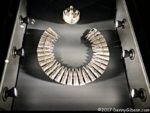
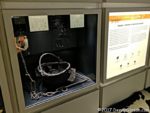 Vikings were not a race or even a nation. In fact, they didn’t use the word to identify themselves but to identify something they did. To go viking meant to go on an adventure. Sometimes they did go viking in order to pillage and burn but often it was to trade or explore. The exhibit includes plenty of items from their peaceful farms and villages and there are many examples of fine craftsmanship and artistry. Of course not all of items found in the Viking’s Scandinavian homelands were made there. Many were obtained through trading or raiding.
Vikings were not a race or even a nation. In fact, they didn’t use the word to identify themselves but to identify something they did. To go viking meant to go on an adventure. Sometimes they did go viking in order to pillage and burn but often it was to trade or explore. The exhibit includes plenty of items from their peaceful farms and villages and there are many examples of fine craftsmanship and artistry. Of course not all of items found in the Viking’s Scandinavian homelands were made there. Many were obtained through trading or raiding.
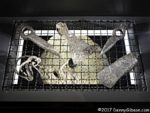
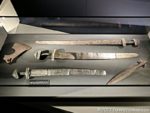
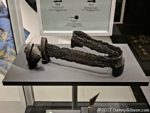 Apparently raiding still forms a major portion of my personal Viking image. I looked over reproductions of clothing and was actually quite impressed by the many examples of artistic metal work but when I got home and looked at the pictures I’d taken, I found mostly weapons or heavy tools. It’s possible that they were just the most photogenic but it seems at least as likely that they simply fit my preconceived notion of the Viking world.
Apparently raiding still forms a major portion of my personal Viking image. I looked over reproductions of clothing and was actually quite impressed by the many examples of artistic metal work but when I got home and looked at the pictures I’d taken, I found mostly weapons or heavy tools. It’s possible that they were just the most photogenic but it seems at least as likely that they simply fit my preconceived notion of the Viking world.

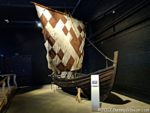
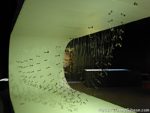 But perhaps even more than the beards and swords, my concept of Vikings is fueled by the visual of a sleek longship floating gracefully through a fjord. The Vikings: Beyond the Legend exhibit includes four ships. A glimpse of the 21 foot long Karl, a reconstruction, can be seen at the left side of the dim photo marking this article’s second paragraph. The first picture here is of part of a ghost ship defined by metal rivets suspended where they would have held the long ago rotted planks of a hull in place. The second is of the 26 foot Krampmacken. In the 1980s, this reconstructed merchant ship sailed from the island of Gotland to Istanbul. The last picture shows the reason this is physically the largest exhibit mounted by the Cincinnati Museum Center. At 122 feet long, the Roskilde 6 is the longest Viking ship ever discovered. The ship is outlined by a modern skeleton that holds approximately 25% of the thousand year old hull in place. This is the first time it has been displayed outside of Europe.
But perhaps even more than the beards and swords, my concept of Vikings is fueled by the visual of a sleek longship floating gracefully through a fjord. The Vikings: Beyond the Legend exhibit includes four ships. A glimpse of the 21 foot long Karl, a reconstruction, can be seen at the left side of the dim photo marking this article’s second paragraph. The first picture here is of part of a ghost ship defined by metal rivets suspended where they would have held the long ago rotted planks of a hull in place. The second is of the 26 foot Krampmacken. In the 1980s, this reconstructed merchant ship sailed from the island of Gotland to Istanbul. The last picture shows the reason this is physically the largest exhibit mounted by the Cincinnati Museum Center. At 122 feet long, the Roskilde 6 is the longest Viking ship ever discovered. The ship is outlined by a modern skeleton that holds approximately 25% of the thousand year old hull in place. This is the first time it has been displayed outside of Europe.
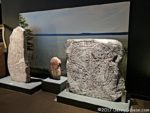 These are reproductions of three of the more than 3,200 rune stones have been found throughout Scandnavia. Scholars consider the Viking Age to be bounded by their destruction of the abbey at Lindisfarne in 783 CE and their defeat at the Battle of Stamford Bridge in 1066. During that time Christianity made major progress in replacing the worship of a collection of gods headed by Odin. While the rune stones were typically erected to commemorate some significant event, many include Christian components and some think they may have at least partially been advertisements for the newer religion.
These are reproductions of three of the more than 3,200 rune stones have been found throughout Scandnavia. Scholars consider the Viking Age to be bounded by their destruction of the abbey at Lindisfarne in 783 CE and their defeat at the Battle of Stamford Bridge in 1066. During that time Christianity made major progress in replacing the worship of a collection of gods headed by Odin. While the rune stones were typically erected to commemorate some significant event, many include Christian components and some think they may have at least partially been advertisements for the newer religion.
